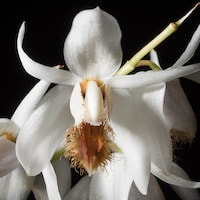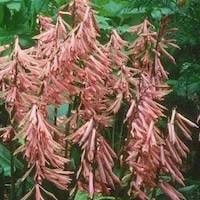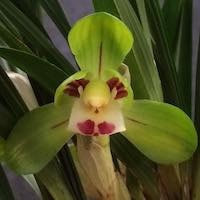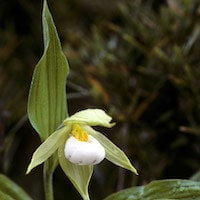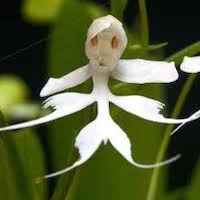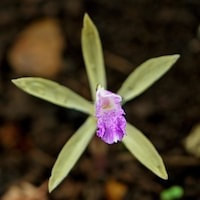WFR2 - Women's Fresh 2 - Fresh off the note
|
Native Singaporean Orchid notes: Bulbophyllum Vaginatum
Cymbidium Finlaysonianum, a widespread orchid found in Singapore, thrives on large trees, rocks, and well-lit open areas like forests and coastal regions. Its fragrant blossoms are long-lasting, with some noting a hint of coconut in its scent. In traditional Malaysian medicine, it was used to counter bewitchment, believed to cure illnesses caused by malevolent spirits. However, caution is advised as further research and expert advice are needed before considering medicinal use of Cymbidium Finlaysonianum.
|
Therapeutic Orchid notes:
|
Coelogyne barbata Lindl. ex Griff.
Xuchunbeimu Lan, also known as the "beard and lip pearl shell orchid," is a Chinese medicinal orchid named Fengian. It is used in traditional medicine in two main ways: First, a decoction made from 15-30 grams of the plant treats lung heat conditions like coughs, sore throats, and hernia-related pain. Second, the orchid is ground into a paste for external use on bruises, sprains, and dry hands or feet. While these uses are established in traditional Chinese medicine, it's advisable to consult healthcare professionals before using Xuchunbeimu Lan or any herbal remedy. |
|
Cremastra appendiculata (D. Don) Makino Syn. Crematra variabilis (Blume) Nakai; Cym- bidium wallichiana Lindl.
Cymbidium appendiculatum, known as Mabian Lan or horse whip orchid in Chinese, has multiple traditional names across Asia, reflecting its widespread medicinal use. Scientific studies have identified 5,7-dihydroxy-3-(3-hydroxy-4-methioxybenzyl)-6-methoxychroman-4-one, a homoisoflavanone compound in this orchid. It inhibits cell growth factors, showing anti-inflammatory and anti-allergic effects by reducing inflammation and protecting against UV-induced skin damage. Additionally, Cymbidium appendiculatum contains tyrosine, promoting melanin formation for skin darkening and UV protection. Traditional uses date back to the Tang Dynasty, treating conditions from impotence to abscesses, indicating its historical significance and potential modern therapeutic applications pending further research and professional consultation. |
|
Cymbidium goeringii (Rchb. f) Rchb. f.
Cymbidium goeringii, known by various local names across Asia, emits a faint floral fragrance due to compounds like methyl-cis(z)-dehydrojasmonate and neroldol. This orchid species thrives in stony habitats and sparse forests across China, Bhutan, India, Korea, and Japan, blooming from January to March. Phytochemical studies reveal medicinal compounds such as Cymbidine A and gigantol, known for their diuretic, hypotensive, and anti-inflammatory effects by inhibiting cytokine release and NF-kappaB activation. In traditional Chinese medicine, it is used to treat various ailments including trauma, lung heat, coughs, sore throat, and worm infestations, highlighting its cultural and potential medicinal significance pending further research and professional guidance. |
|
Cypripedium cordigerum D. Don
Cypripedium cordigerum, known as Baichunshao Lan in Chinese and Jibri in Nepali, thrives in grasslands, meadows, and pine forests across Nepal, Tibet, Bhutan, Kashmir, and Pakistan. In traditional herbal practices, its roots are valued as a tonic in Nepal, believed to enhance overall health and vitality. Moreover, the young leaves are prepared as a nutritious vegetable, supporting local diets. However, caution is advised regarding traditional herbal uses, emphasizing the importance of consulting healthcare professionals for safe and effective usage. |
|
Habenaria crinifera Lindl.
In the Kudremukh National Park in Karnataka, tribes use the tubers of Habenaria crinifera for medicinal purposes, particularly to treat headaches. These tubers are processed in ways that make them effective for alleviating headache symptoms. It's crucial to understand that herbal remedies can have different effects depending on how they are used and on individual health conditions. Therefore, seeking advice from healthcare professionals or experienced practitioners is recommended for safe and appropriate use of such remedies. |
|
Nervilia crociformis (Zoll. and Mor.) Seidenf.
The orchid known as Baimaiyu Lan, or Bua sandot in Thai, is found across tropical and subtropical regions of the Old World, including Australia and the Pacific, often in grasslands. In Thailand, its pseudobulbs are used in traditional medicine to treat faintness. These pseudobulbs are likely processed to create remedies that alleviate fainting symptoms. It's important to note that herbal uses can differ widely by culture, so consulting with healthcare professionals or experienced practitioners is advisable for accurate guidance on using herbal remedies safely and effectively. |
Other scent note
Scentopia Library Reference ingredient
Chamomile - Check details at Scentopia's scent library
Download the guided mediation that works best with this Orchid fragrance oil
| women_fresh_essential_oil_orchi_00002.mp3 | |
| File Size: | 158523 kb |
| File Type: | mp3 |

